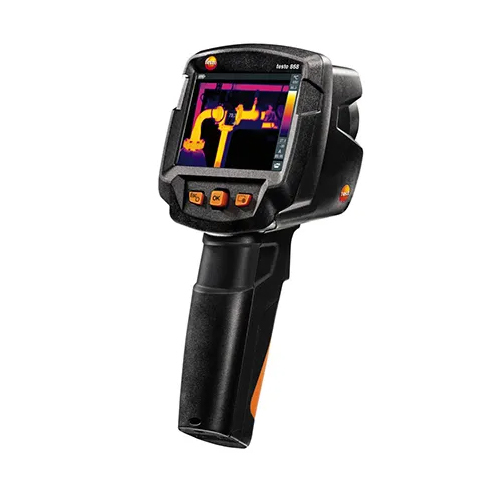Thermal Imager
Price 120000.00 INR/ Piece
Thermal Imager Specification
- Product Type
- Thermal Imager
- Usage
- For Electronics, research labs, material analysis,
- Weight
- 500-800 Grams (g)
- Material
- Metal And Plastic
- Power Supply
- Battery
- Display Type
- Analog Only
Thermal Imager Trade Information
- Minimum Order Quantity
- 1 Piece
- Supply Ability
- 100 Pieces Per Week
- Delivery Time
- 1 Week
- Main Domestic Market
- All India
About Thermal Imager
Specifications:
- Infrared resolution 160 x 120 pixels
- With testo Super Resolution to 320 x 240 pixels
- With testo Scale Assist
- Thermal sensitivity < 120 mK
- Automatic recognition of hot-cold spot
Precision for Research and Industry
Our thermal imager is tailored for electronics diagnostics, laboratory research, and material analysis. Its portable build and resilient materials ensure dependable operation even in demanding environments. The analog display delivers precise thermal readings critical for cutting-edge research and technical inspections.
Portable and User-Friendly Design
Weighing between 500 and 800 grams, this thermal imager is easy to transport and maneuver during field studies or lab work. Battery operation removes the need for direct power sources, enabling on-site assessment and uninterrupted workflow across different locations.
FAQs of Thermal Imager:
Q: How does this thermal imager benefit professionals in research and electronics?
A: By providing accurate surface temperature readings, this thermal imager helps professionals identify heat patterns in electronic circuits, materials, and lab samples, facilitating efficient troubleshooting, quality analysis, and experimental documentation.Q: What is the recommended process for using this device in material analysis?
A: To use this thermal imager for material analysis, power the device with batteries, activate the analog display, and direct the imager toward the item under examination. You can then interpret the thermal patterns shown on the display to assess temperature variations and material properties.Q: When should I consider using a thermal imager with an analog display rather than a digital one?
A: Analog displays are particularly useful for applications requiring real-time observation without data lag. They are reliable in environments with digital interference, and users who prefer immediate, straightforward readings often choose analog models for their simplicity.Q: Where is this thermal imager manufactured and supplied?
A: This thermal imager is manufactured and supplied in India, ensuring local support, quality assurance, and timely availability for Indian research, laboratory, and industrial sectors.Q: How is this device powered and what are the benefits of battery operation?
A: The device operates using batteries, which enables portable use, reduces dependency on fixed power sources, and allows for flexible operation during fieldwork or within labs where electrical outlets may be limited.Q: What materials are used in constructing this thermal imager and why?
A: The imager is constructed from a blend of metal and plastic. This offers a balance between sturdiness (for longevity and durability) and lightness (for easy handling), ensuring the device withstands rigorous use while remaining comfortable to operate.
Tell us about your requirement

Price:
Quantity
Select Unit
- 50
- 100
- 200
- 250
- 500
- 1000+
Additional detail
Mobile number
Email
More Products in Thermal Imagers Category
Testo 872- Thermo vision camera with Wi Fi
Price 396000.00 INR / Piece
Minimum Order Quantity : 1 Piece
Usage : For Electronics, research labs, material analysis,
Power Supply : Battery
Material : Metal And Plastic
Weight : 300800 Grams (g)
Testo 868- Thermal Camera
Price 203000.00 INR / Piece
Minimum Order Quantity : 1 Piece
Usage : For Electronics, research labs, material analysis,
Power Supply : Battery
Material : Metal And Plastic
Weight : 200800 Grams (g)
Thermal Imager With Auto Image Management
Price 430000.00 INR / Piece
Minimum Order Quantity : 1 Unit
Usage : Industrial
Power Supply : 230V
Material : Metal

 Send Inquiry
Send Inquiry Send Inquiry
Send Inquiry



